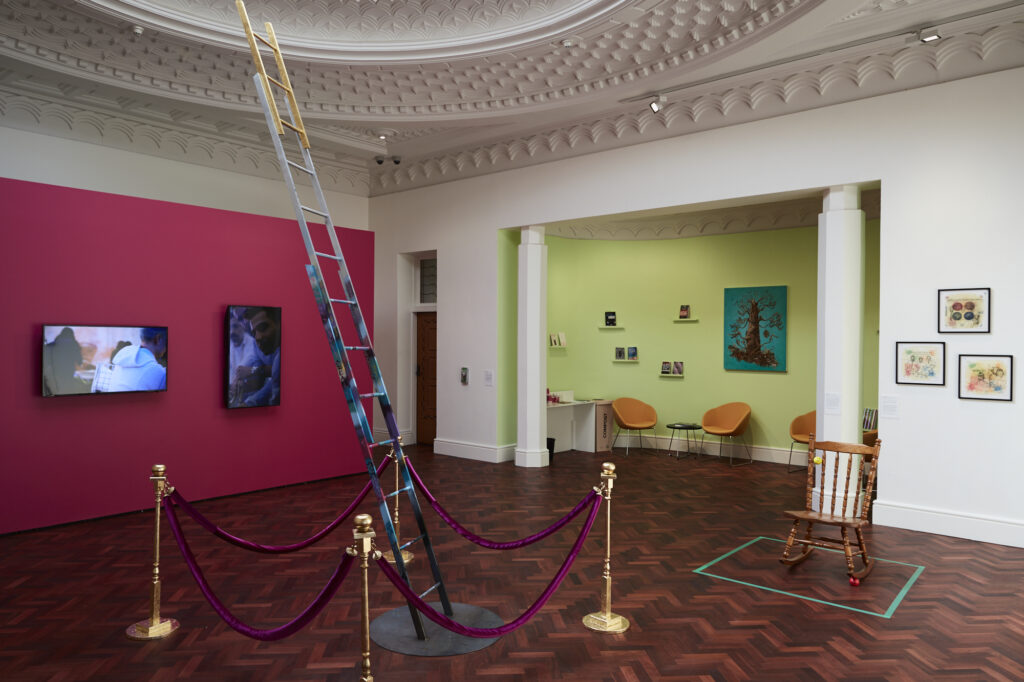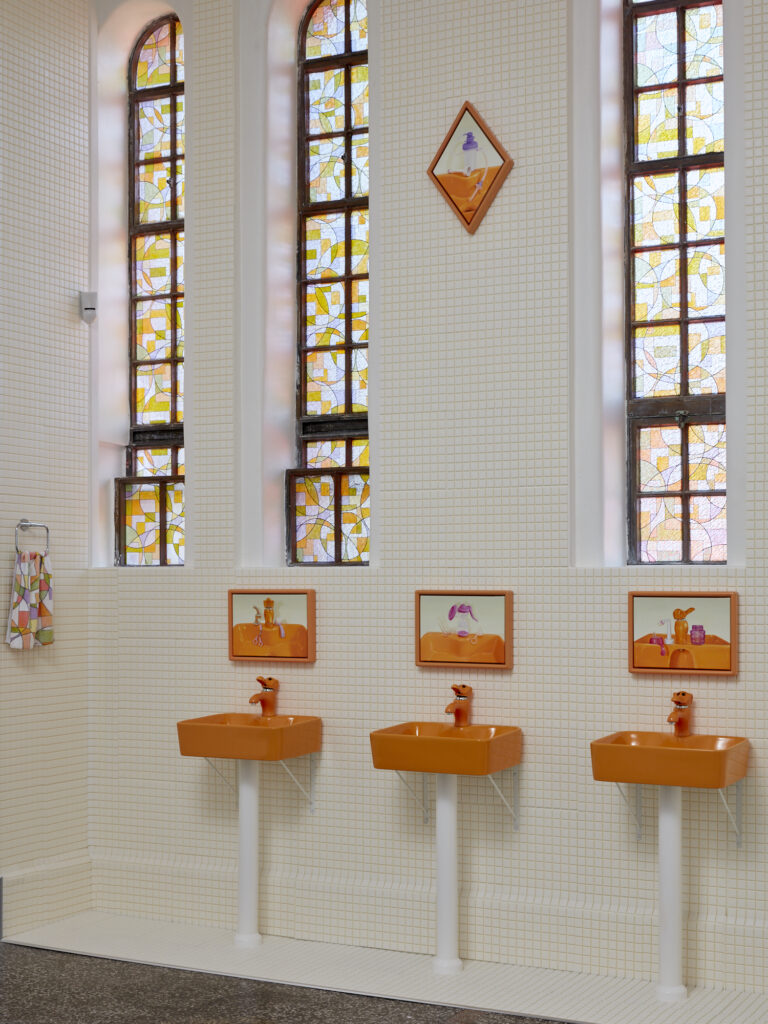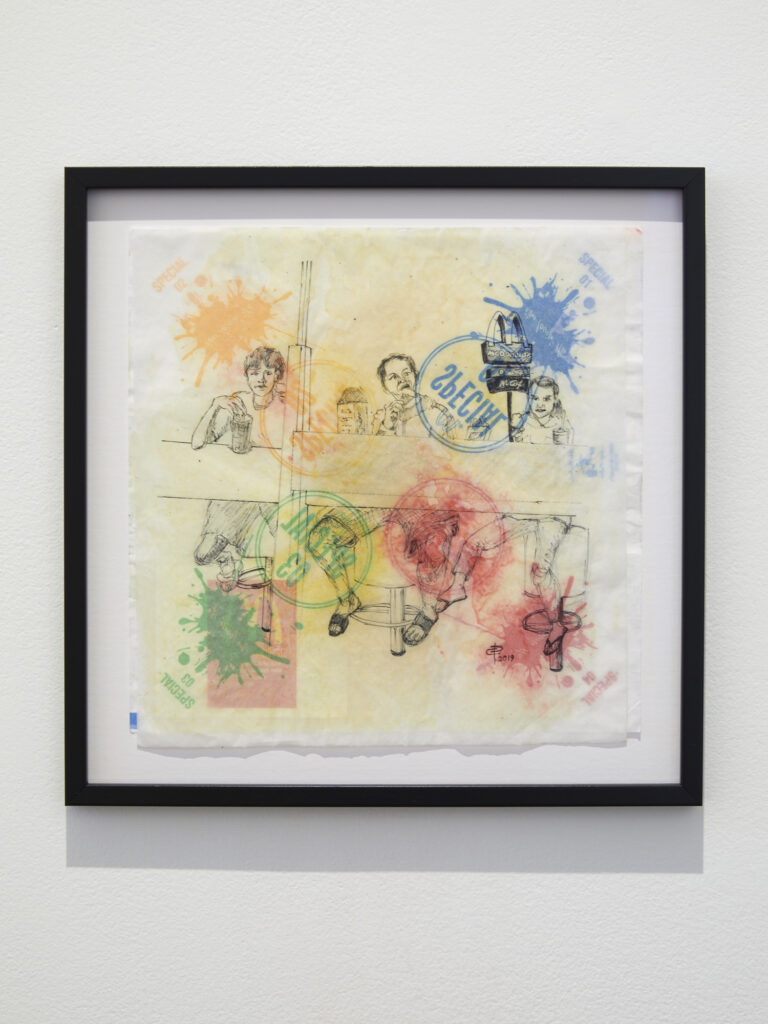
Originally published 28 April 2019 by Circuit Artist Film and Video
Drawing its title from a Four Square advert, We’re not too big to care is a defiant proclamation for the newly relaunched Gus Fisher Gallery. Now under the helm of Lisa Beauchamp, the gallery is attempting to break down institutional barriers with its high-impact, of-the-moment, and inclusive programming. This is a gallery that wants to be for the people, serving as a social conscience within the corporate high rises of Auckland’s CBD. In itself, this isn’t unique given the current climate of moral righteousness within local and international exhibits. However, mired as it is within the university behemoth, the Gus Fisher Gallery has a lot prove to itself.
We’re not too big to care is an ambitious show of 16 local and international artists that looks at the slow erosion of civil liberties and economic agency that has beset contemporary society, exposing the inequalities that touch every level of humanity activity. At its centre is Cao Fei’s monumental Asia One. Commissioned in 2018 for the Guggenheim Museum, Asia One is a cinematic study in emotional longing and alienated labour set within an already-realised automated future. Filmed onsite at a JD.com warehouse, the second largest ecommerce in China with deep links to the state, Asia One might be thought of as a dystopian film where artificial intelligence and robotics have usurped human labour.
Yet at it’s core, Asia One is a story about a girl, a boy, and a robot whose achingly fraught interactions at a fully-automated distribution centre act as a prosthesis for the tripartite relationship between human, non-human and their absence. Thrown into relief by their isolation and the constant roar of machinery, the film’s protagonists cycle between states of euphoria, disillusionment and boredom, drawing close to one another only to be repulsed through the matrix of narrowly encoded behaviours. Their human desires have become subjugated to the authority of the supply chain, a merely blip within the system of big data which they serve. Unfettered by the need to make decisions, the girl and the boy are left to simply observe, to enact small gestures of agency, and to dream.
In one such hallucinatory dance sequence, lithe young bodies gyrate around the factory next to banners reading “Man and machine go hand in hand and create miracles.” Besides being an actual slogan of JD, the scene is reminiscent of Maoist era ballets and revolutionary pageants. In Cao’s work, we see a can see automation as a kind of endpoint for the Great Leap Forward, a political legacy 70 years in the making that is inseparable from China’s lived reality and it’s future. Where in Aotearoa we might conceive of technology and robotics as economic questions, they are in fact deeply political. Acting as a pendant to Asia One, 11.11 is a documentary style film that follows real life couriers for JD within Beijing in the lead up to Single’s Day, the largest online and offline shopping day in China (in 2018, JD made US$23 billion within the trading period). Here, the couriers juggle the ever increasing demands of escalating consumption with family life, and foresee the technological advance which threatens their very livelihoods. We follow them into the maze-like labyrinth of hutong, their own small apartments that house multiple generations, and rally with them in their small successes. They are only too aware of the precarious labour they perform, riding the wave that preceeds an inevitable collapse. Recently, JD chief executive Liu Qiangdong said that China could “realise the dream of Communism within our generation.”1 But this realisation will also signal one of the greatest challenges that AI poses to contemporary China – the large-scale displacement of domestic migrant workers. Herein lies the power of Asia One, bringing into focus the complex interrelationship of hyperbolic industry, social disintegration and pervasive consumerism besetting contemporary China.
Right: Carole Prentice, Loving It, 2019. Image © the artist and Mokopōpaki, Auckland. Photography by Sam Hartnett.
In the centre of the Gus Fisher, reaching up towards the domed glass ceiling is Aroha Novak’s The right be be unequal. Carefully guarded behind kitsch pink velvet rope, a tall painted ladder leans towards a golden apex, the bottom which is muddied with graffiti, purples, blues and greens. Novak’s work is an investigation into Aotearoa’s neoliberal reforms and the glass ceiling that it has placed on those most in need. ROGERNOMICS and HE AHA TE MEA NUI O TE AU? are scrawled brazenly in paint marker, alongside quotes from former prime ministers vandalising a dream of economic and social security through free market policies. At each turn, we are confronted by physical barriers: stanchions, a steep incline, a precipitous fall. We feel the physical vulnerability of the work and the ideals it symbolises – an ideal that yet falls short of its mark.
If The right to be unequal and Asia One point towards current and near future states of disenfranchisement, then Blue Monday by The Duvet Brothers marks the emergence of the neoliberal reforms that enabled it. Made in 1984, Blue Monday is a scratch film that coincides with the beginning of youth television culture, appropriating mass media communications, news footage and pop music to create an iconoclastic image of Thatcherite Britain. Images of Thatcher herself, Reagan, the royal family and trimly suited men are aggressively juxtaposed against civilian clashes with armed police forces, military drills and post-industrial wasteland that seem prophetic of some immanent natural disaster. All the while New Order’s electronica thumps along, better suited to a disco than a gallery. In fact, Blue Monday and other such scratch films were once screened in clubs, a decidedly anti-establishment and politically oppositional gesture that attempted to subvert mainstream broadcasting and pop culture, even the nullifying effects of the gallery itself.
It’s with some irony then that we find Blue Monday here, an angry howl against the privatisation of state services and broadening class inequality stuck in a feedback loop – we might have moved forward, but nothing has really changed.
Carol Prentice presents a new suite of drawings on McDonald’s burger wrappers that reveals a largely forgotten moment in Aotearoa’s entrepreneurial history. These loose, unfettered works have been inspired by her uncle’s own restaurant, also named McDonald’s, the first to sell french fries takeway in New Zealand and later bought out by the multi-national fast food chain. Scenes of individuals and families enjoying a meal together at bar-height tables are deliberately drawn from photographs of both her uncle’s establishment in the 1950s and ones from the Golden Arches. By conflating these two experiences, Prentice illustrates how globalisation can subsume individual interests by selling us a dream of something we think we want, of something that we truely deserve. While the introduction of McDonald’s to the local market was met with resistance from both sides – skepticism that American products would take off in ‘provincial’ New Zealand, and hard-line regulations against foreign imports – it was quickly realised that rather than catering to New Zealand tastes, it was simpler to convert New Zealander’s to the taste of McDonald’s. Prentice’s work plays off this distortion.
In a site responsive installation, Emily Hartley-Skudder presents an installation of vibrant paintings and found objects within the former womens’ bathrooms. Having recently undertaken a residency in Xiamen, China, Hartley-Skudder has been creating works composed of consumer cosmetic and hygiene products that neatly efface their bodily interactions. Arranged as a beguiling still life, and reminiscent of immaculate shop displays, are a set of three orange bathroom sinks with matching anthropomorphic taps. Above each sink is a small life-sized vanitas depicting said sink and an assortment of feminine devices: a breast pump, douche and speculum all feature. If still lives are often about the transience of life and pleasure, Hartley-Skudder’s are a vision of plastic immortality, where the female body is trapped within the machine of resplendent consumption.
Many of the other works in this show have a cyclical nature, echoing the repetition of labour that industrialisation heralded. Miranda Bellamy’s Meme shows an endless stream of cars entering a McDonald’s drive through over a 24 hour period. Gabrielle Amodeo’s Little Blue Boy, a stop motion film of the Cerebos salt boy, runs tirelessly forward. Jame’s R Ford’s Back and Forth and Round and Round is a sculptural work composed of rocking chair and stress balls to be crushed under the weight of human interaction. Revised Payload by Deborah Rundle features a series of punch clocks and cards emblazoned with the figure ‘8’, a symbol of the eight hour work day and infinity.
At times, We’re not too big to care suffers a bit in its pleading tone. Be kinder, respect others, stay informed, care more. Because this exhibition isn’t simply a rally against the privatisation of our everyday interests but a broader proposition on exhibition making and the responsibilities that a cultural institution must take on in relation to their respective audiences. What are its ethics, and what of its duty to care?
At the reopening of the Gus Fisher Gallery, and the opening of this exhibition, it was hard not to notice the self congratulatory remarks made by certain guest speakers on the important role (or lack thereof) that the University of Auckland has to play in supporting the creative arts. Given the recent backlash against the university and its decision close three of its specialist libraries, and the particular vitriol this drew from the students body and cultural commentators alike, the Gus Fisher Gallery needs to be seen as more than a showpiece of the university. The question is whether it can stand up to the university and critique the institutions that also sustain it.
In Angela Tiatia’s The Fall, we bear witness to a lavish premonition of a society in collapse. As the camera slowly pans across a set, actors charge forward with machetes, others loot the shelves of a makeshift supermarket, gorge themselves on sugar or calmly watch on. It’s a scene of excess that draws comparison to Heironymous Bosch’s The Garden of Earthy Delights, recreated from oral accounts from civilian and military survivors of the battle, and eventual fall, of Singapore. Amongst these seething vignettes are the stories of mothers who put flour into the hair of their daughters to make them less attractive to the invading Japanese, and of soldiers who abandoned all hope and bathed in the remains of carefully rationed water. There’s something unsettling in the way that this trauma has been filtered to provide a visually sumptuous cautionary tale. However, in the last frames of The Fall the camera passes across a mirror revealing the artist and camera crew as live agents, suggesting their own complicity in these acts.
Benefiting from relative financial security, the Gus Fisher Gallery should ask itself whether it is not also complicit in the pro-market ideals it sets out to critique. Is free labour not abetted by the competitive basis of neo-liberalism? Although university art galleries globally are no longer bound by traditional demands to be “teaching” facilities, how do we distinguish between what is ‘educational’ and what simply raises the profile of a campus? Have the lines between university art galleries and their civic counterparts become too blurred? Does it matter? Regardless, We’re not too big to care raises a lot of interesting propositions. It’s worth visiting for Asia One alone. Yet collectively the works in this exhibition form a compelling ensemble, a truely challenging exhibition that is currently often missing within Tāmaki Makaurau. Let’s hope that this is just the beginning of more good things to come.
1 Jiayang Fan, “How E-commerce Is Transforming Rural China”, The New Yorker, July 16, 2018.

